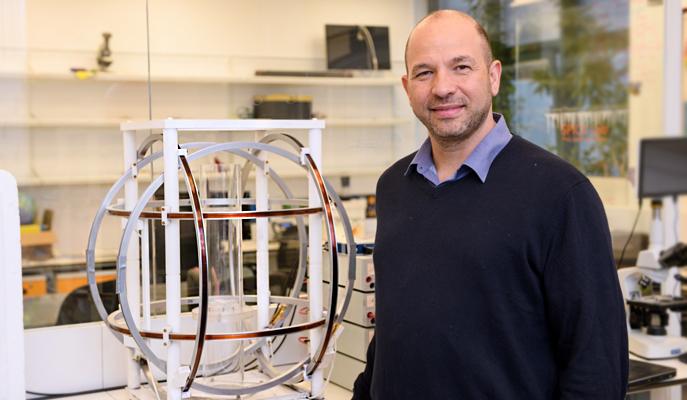The findings could help us understand the history of other bodies in our solar system

Credit: Weizmann Institute of Science
The history of our planet has been written, among other things, in the periodic reversal of its magnetic poles. Scientists at the Weizmann Institute of Science propose a new means of reading this historic record: in ice. Their findings, which were recently reported in Earth and Planetary Science Letters, could lead to a refined probing ice cores and, in the future, might be applied to understanding the magnetic history of other bodies in our solar system, including Mars and Jupiter’s moon Europa.
The idea for investigating a possible connection between ice and Earth’s magnetic history arose far from the source of the planet’s ice – on the sunny isle of Corsica, where Prof. Oded Aharonson of the Institute’s Earth and Planetary Sciences Department, was attending a conference on magnetism. More specifically, the researchers there were discussing the field known as paleo-magnetism, which is mostly studied through flakes magnetic minerals that have been trapped either in rocks or cores drilled through ocean sediments. Such particles get aligned with the Earth’s magnetic field at the time they are trapped in place, and even millions of years later, researchers can test their magnetic north-south alignment and understand the position of the Earth’s magnetic poles at that distant time. The latter is what gave Aharonson the idea: If small amounts of magnetic materials could be sensed in ocean sediments, maybe they could also be found trapped in ice and measured. Some of the ice frozen in the glaciers in places like Greenland or Alaska is many millennia old and is layered like tree rings. Ice cores drilled through these are investigated for signs of such things as planetary warming or ice ages. Why not reversals in the magnetic field as well?
The first question that Aharonson and his student Yuval Grossman who led the project had to ask was whether it was possible that the process in which ice forms in regions near the poles could contain a detectable record of magnetic pole reversals. These randomly-spaced reversals have occurred throughout our planet’s history, fueled by the chaotic motion of the liquid iron dynamo deep in the planet’s core. In banded rock formations and layered sediments, researchers measure the magnetic moment – the magnetic north-south orientations – of the magnetic materials in these to reveal the magnetic moment of the Earth’s magnetic field at that time. The scientists thought such magnetic particles could be found in the dust that gets trapped, along with water ice, in glaciers and ice sheets.
The research team built an experimental setup to simulate ice formation such as that in polar glaciers, where dust particles in the atmosphere may even provide the nuclei around which snowflakes form. The researchers created artificial snowfall by finely grinding ice made from purified water, adding a bit of magnetic dust, and letting it fall though a very cold column that was exposed to a magnetic field, the latter having an orientation controlled by the scientists. By maintaining very cold temperatures – around 30 degrees Celsius below zero, they found they could generate miniature “ice cores” in which the snow and dust froze solidly into hard ice.
“If the dust is not affected by an external magnetic field, it will settle in random directions which will cancel each other out,” says Aharonson. “But if a portion of it gets oriented in a particular direction right before the particles freeze in place, the net magnetic moment will be detectible.”
To measure the magnetism of the “ice cores” they had created in the lab, the Weizmann scientists took them to Hebrew University in Jerusalem, to the lab of Prof. Ron Shaar, where a sensitive magnetometer installed there is able to measure the very slightest of magnetic moments. The team found a small, but definitely detectible magnetic moment that matched the magnetic fields applied to their ice samples.
“The Earth’s paleo-magnetic history has been studied from the rocky record; reading it in ice cores could reveal additional dimensions, or help assign accurate dates to the other findings in those cores,” says Aharonson. “And we know that the surfaces of Mars and large icy moons like Europa have been exposed to magnetic fields. It would be exciting to look for magnetic field reversals in ice sampled from other bodies in our solar system.”
“We’ve proved it is possible,” he adds. Aharonson has even proposed a research project for a future space mission involving ice core sampling on Mars, and he hopes that this demonstration of the feasibility of measuring such a core will advance the appeal of this proposal.
###
Prof. Oded Aharonson is Head of the Helen Kimmel Center for Planetary Science; his research is also supported by the Minerva Center for Life Under Extreme Planetary Conditions; the Zuckerman STEM Leadership Program; and the Adolf and Mary Mil Foundation.
The Weizmann Institute of Science in Rehovot, Israel, is one of the world’s top-ranking multidisciplinary research institutions. Noted for its wide-ranging exploration of the natural and exact sciences, the Institute is home to scientists, students, technicians and supporting staff. Institute research efforts include the search for new ways of fighting disease and hunger, examining leading questions in mathematics and computer science, probing the physics of matter and the universe, creating novel materials and developing new strategies for protecting the environment.
Media Contact
Gizel Maimon
[email protected]
Original Source
https:/
Related Journal Article
http://dx.




